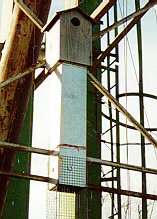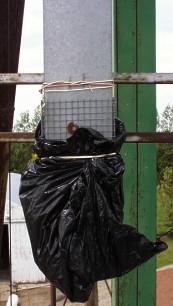 |
 |
| Above is one of my European Starling traps in a
Silver Maple tree. It is about 10 feet long.
I used a regular birdhouse without a bottom, then I had a 5" by 5" duct work made to deliver the birds to ground level. Below shows the dramatic decrease in the Starling & Sparrow populations I have obtained by agressive trapping. Starlings trapped--- 1993 80 1994 110 1995 106 1996 96 1997 25 1998 16 1999 14 English Sparrows trapped--- in other types of traps Sparrows won't go into the Starling trap 1993 10 1994 84 1995 140 1996 54 1997 19 1998 18 1999 10 |
 I got the idea for the trap when I realized that Starlings will jump into any dark area. We have a couple open ports in our grain elevator leg distributor and the Starlings will jump down the 50 foot downspouts and get trapped in the bins. I place a bag over the screen access door at the bottom so the duct work is dark inside. The Starlings jump in and can't fly back out. The great thing about this trap is that no other "Good" birds will jump into it. |